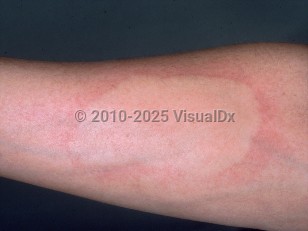Cold urticaria in Adult
Alerts and Notices
Important News & Links
Synopsis

Wheals are usually localized to the area of contact, but they may be more generalized in the setting of extensive cold exposure. Systemic symptoms of flushing, headache, syncope, and abdominal pain may also develop if large areas are affected, such as after aquatic activities. One large study also found that onset of cold urticaria in childhood was associated with systemic symptoms after immersion in cold water. Angioedema may be a feature, and of the chronic inducible urticarias, this subtype is one of the more common to be complicated by anaphylaxis. Some studies have found that over one-third of individuals with cold urticaria also experience anaphylactic reactions to cold. Individuals with the shortest time to onset of wheals often have more severe symptoms, with onset in less than 3 minutes being associated with a higher risk of hypotensive episodes. One large study identified angioedema, oropharyngeal involvement, and itchy earlobes to be risk factors for cardiovascular manifestations of cold urticaria.
Cold urticaria is often chronic, and approximately 30%-70% of affected adults achieve remission within 5 years.
Primary cold contact urticaria is the most commonly encountered form (95% of cases). It is often idiopathic but may follow respiratory infections or arthropod bites / stings or occur in association with HIV. Primary cold contact urticaria may occur at any age, but it is most frequently seen in young adults. Wheals lasting less than 24 hours are observed.
Secondary cold contact urticaria is seen with serum abnormalities such as cryoglobulinemia, cryofibrinogenemia, or circulating cold agglutinins. It is rare and is seen in association with Raynaud phenomenon and purpura. Wheals may last longer than 24 hours.
Reflex cold urticaria occurs after generalized cooling of the body, which induces widespread wheals. Patients may experience life-threatening anaphylaxis from exposures such as diving into a cold lake. Hives can be observed if patients are placed in a very cold room, but this should not be performed as it may induce anaphylaxis.
Familial cold autoinflammatory syndrome (FCAS) is a subtype of cryopyrin-associated periodic syndrome (CAPS). FCAS typically presents within the first 6 months of life with recurrent outbreaks of fever, arthralgia, fatigue, and nonpruritic urticaria that occurs after cold exposure.
Codes
L50.2 – Urticaria due to cold and heat
SNOMEDCT:
74774004 – Cold urticaria
Look For
Subscription Required
Diagnostic Pearls
Subscription Required
Differential Diagnosis & Pitfalls

Subscription Required
Best Tests
Subscription Required
Management Pearls
Subscription Required
Therapy
Subscription Required
Drug Reaction Data
Subscription Required
References
Subscription Required
Last Updated:02/17/2022

